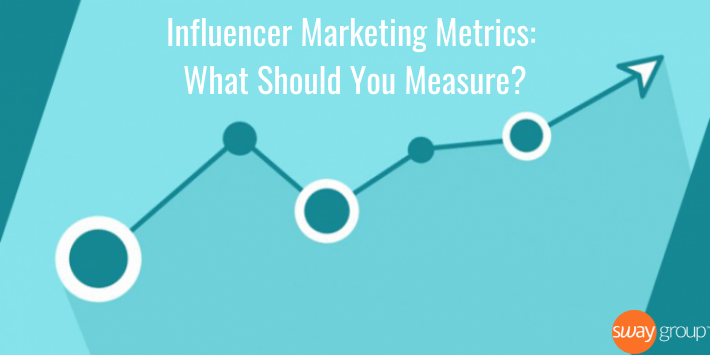We get asked a lot, how do you measure influencer marketing success? What are the influencer marketing metrics to focus on?
In just a handful of years, influencer marketing has grown from a cutting-edge tactic to a mainstream marketing strategy. While influencer marketing has shown itself to be a highly targeted, impactful alternative to traditional ‘spray-and-pray’ advertising, it can be challenging for brands to understand which social media metrics to focus on.
Influencer marketing metrics have evolved along with the industry, and it’s important to evaluate the right data sets in order to determine success.
One of the biggest pitfalls brands can run into with influencer marketing metrics is over-valuing impressions, which are the number of times a piece of content is served up to someone’s feed. With reach and impressions, it’s possible to determine how many people were exposed to a piece of campaign content — but neither of those metrics offer any useful insight into how the content was received.
How do you measure influencer marketing?
There are much better ways to measure the success of influencer marketing programs. In order to truly understand a campaign’s effectiveness, brands need to analyze the actions people took when they encountered the promoted content.
Likes, comments, saves, shares: all of these engagement metrics help demystify campaign reach, and more importantly, they reveal levels of audience interest.
Engagement gives brands the opportunity to listen, share, and build lasting relationships with customers. Let’s take a look at the most important influencer marketing metrics that today’s brands should be focusing on.
6 Influencer Marketing Metrics That Determine Success
1) Saves.
Post saves are one of the most valuable engagement metrics. If a consumer saves an influencer post, it indicates they’re very interested in the content and intend to come back to it later.
While saves are not a public facing metric the influencer always has access to the number. It is an important metric to ask for if you’re not working with an agency that has API-authenticated data access.
2) Clicks.
Clicks/click-throughs show that audiences are taking action from the influencer’s content. Not only do clicks measure the levels of interest shown by the influencer’s audience, they also allow brands to track precisely how much traffic their influencer marketing campaign sent to their promoted landing page.
Brands should use unique trackable links (via Bitly or other URL-shortening services) in order to understand campaign performance and individual influencer ROI. Influencers can use these trackable links wherever they include their call to action: via a link in their social media bio, Instagram Stories swipe up, within blog content, etc.
Another option for deep-dive tracking is to work with an influencer marketing agency. Sway Group influencers are required to provide access to platform API-authenticated data, which means our clients can count on accuracy in demographics and reporting.
Our custom-built influencer dashboard that was developed in partnership with CreatorIQ allows for deep-dive analytics that helps clients understand the who, what, where, and when of the traffic within their campaign.
Sway Group influencers are also able to include trackable retargeting pixels in blog posts for agencies and brands who want to compliment promotional posts with same-campaign advertising. Retargeting pixels can also be used to build influencer lookalike audiences for even wider reach through programmatic advertising.

3) Shares.
Shares/retweets are another extremely useful quality indicator: both of these actions show that audiences liked the content enough to share it with their own social networks.
Sharing branded content is a strong sign of interest among influencer audiences, and a powerful way to widen campaign impact. Organic shares can lend credibility to branded content, amplify campaign performance, and generate new brand social account followers.
4) Reactions.
Social media reactions include likes, but can extend to a variety of emotions depending on the platform. Since choosing a reaction beyond a like or thumbs up takes more effort, reactions are a useful gauge for understanding audience sentiment.
Facebook’s spectrum of reaction choices now includes love, laughter, sadness, caring, anger, and wow, while LinkedIn offers celebrate, support, curiosity, and more. This far more interactive way of reacting to content encourages audience engagement and helps brands gain more insights into campaign effectiveness.
Reactions are a way for brands to assess the emotional impact of their branded content. They also provide opportunities for brands to expand their influencer marketing goals beyond driving “like” engagements. A more nuanced approach that appeals to a range of sentiments can help brands build more meaningful, long-term consumer connections.
5) Likes.
Likes are the most simple way to measure content appreciation. Even as social media platforms go back and forth on whether to publicly display likes, they offer brands one way to quantify brand buzz.
When someone hits the like button, they’re indicating some amount of involvement with the content itself. A like at least ensures the content was noticed, as opposed to an impression. However, in our click-happy culture, liking a post may in fact be an indication of true interest — or it may be a routine, somewhat mindless action on the user’s part.
The more likes a social post receives, the more likely it is to be prioritized by platform algorithms and shown to more audiences, driving more views and engagements.
6) Comments.
Comments are perhaps the most revealing engagement metric of all, depending on what brands do with that data. Comment counts on influencer-shared posts can be interpreted as positive engagement, but comments can be both positive and negative.
A high number of comments on a given social post might indicate strong engagement, but it’s critical for brands to take the next step by reviewing the actual sentiment behind these comments. Is there interest being expressed beyond “Great pic”?
Brands should always take the time to review these conversations (and better yet, join in!) in order to read the room. Are there questions being asked, opportunities to provide more information, or intent to purchase being expressed? Digging deeper often provides useful qualitative campaign data that can’t be gleaned from a simple comment tally.
The Final Word on How to Measure Influencer Marketing Success
When it comes to driving real consumer action, like boosting website traffic, online purchases, newsletter signups, app downloads, and more, engagement is the reason influencer marketing is so effective.
Engagement matters because it helps extend organic reach, and even more importantly, it shows you whether or not you have an audience that’s paying attention.
The magic is in the action, and that’s where your measurement efforts should be focused — but don’t stop at simply counting up impressions and likes.
In order to fully understand how your campaign is working and fine-tune your future efforts, take the extra steps to analyze what all that great engagement actually means for your bottom line.
Want some expert help with your influencer marketing metrics? Contact us today to learn more about how we use our content expertise and creator connections to develop exceptional influencer marketing campaigns — with results you can measure.



